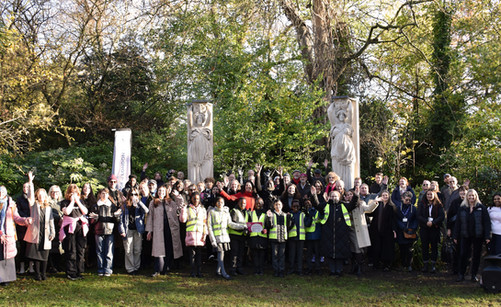We had a fantastic unveiling in Southwark Park this morning to celebrate the restoration of the Caryatids. Many local residents and supporters attended the event, alongside Southwark College and St Joseph's Catholic Primary School and Mayor of Southwark Sunny Lambe.
There were speeches from Dr Nicola Stacey, local resident Gary Magold, Cabinet Member for Parks and Culture, Councillor Ellie Cumbo and Mayor Sunny Lambe.
Young people spoke about their experiences being part of HOLT’s Proud Places programme, the importance of learning about local heritage and how it has helped them feel connected to their new country.
Omar, aged 17: “My name is Omar and I am from Sudan. I’m part of the Proud Places programme. I enjoyed learning about the history of our sculptures and how they were part of old Rotherhithe Town Hall. My favourite part was hearing the stories behind them. Learning about our local history is very important because it helps us understand how our community has changed. Look at them – they are beautiful!”
Ribbons around each statue were cut by pupils from Southwark College and St Joseph's Catholic Primary School alongside the Mayor.
Over 170 young people have been involved in the restoration process as part of Proud Places, meeting the stonemasons at work.
The caryatids were sculpted in 1897 by Henry Poole and stood either side of the doorway to Rotherhithe Town Hall on Neptune Street, a grand Victorian civic building later converted into a library in 1905.
During the Second World War the building was bombed six times, leaving it badly damaged. The caryatids were rescued and in 1974 found a new home on the brutalist Heygate Estate off New Kent Road.
When that estate was demolished in 2011, the statues were moved again to Southwark Park, after a campaign led by Gary Magold.
We are thrilled that they have been fully restored for future generations to enjoy. Thanks to all involved and especially to our donors for this project, Knight Frank.













































































